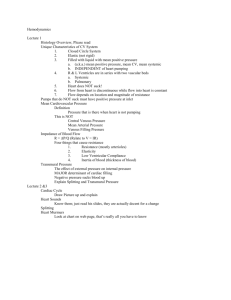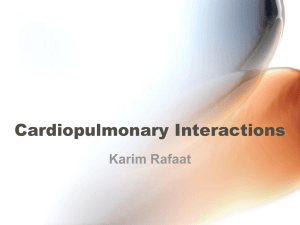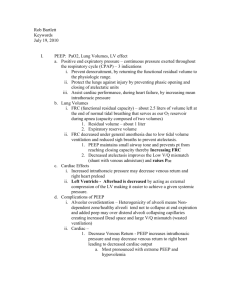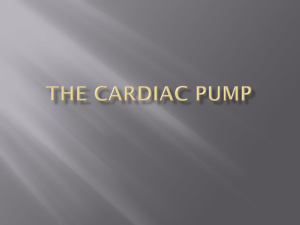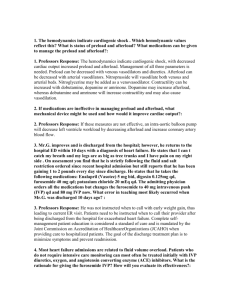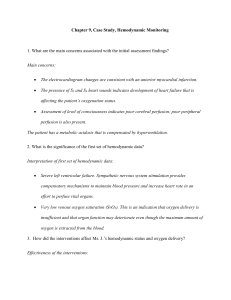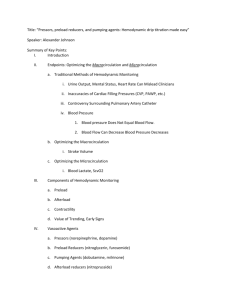Cardiopulmonary Interactions - UC San Diego Health Sciences
advertisement
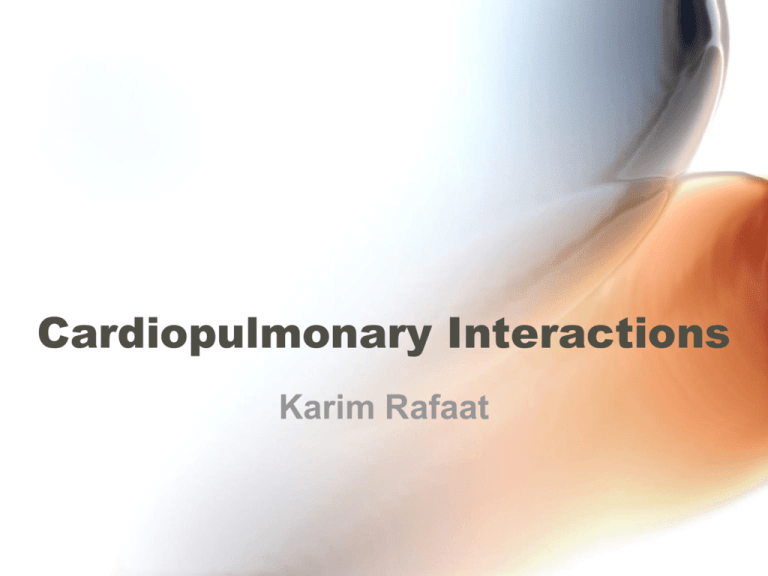
Cardiopulmonary Interactions Karim Rafaat •Two pumps in series in a chamber where pressure is changing •RV reservoir is outside thorax –Subject to atmospheric pressure •RV venous connections in thorax –Subject to thoracic pressure •LV filling reservoir and LV lie in thorax •Intrapleural pressure constantly changes –Fluctuations in intrathoracic pressure will affect output •Alter preload on R •Alter afterload on L •Right and left ventricles share a septum –Changes in contractile state of one, affects the other •Changes in lung volume alter caliber of alveolar vessels, affecting RV afterload •Today, we will step through each bit: –Venous return and RA filling –RV output –Pulmonary Vascular resistance –LV output Spontaneous Breathing Normal heart Venous Return (Preload) • Pressure for venous return – Mean systemic pressure – right atrial pressure • Usually about 5 mmHg and is determined by difference between extrathoracic and intrathoracic venous pressures • Negative intrathoracic pressure increases caliber of intrathoracic veins – Increases preload to RA – Flow limited by the collapse of vena cavae at thoracic inlet Venous Return (Preload) • Increase in venous return during inspiration is countered by the increase in right atrial pressure, which thus decreases the gradient for further flow Right Ventricular Output • Pumps blood through low resistance pulmonary vascular bed • Blood flow through the lung to the left atrium sustained by – Pressure differential through the pulmonary artery, the downstream pressure in the pulmonary resistance vessels and the LA pressure. • Only requires 20-30 mmHg at rest • RV well suited to this – Low pressure, high volume pump – In normal conditions, not too needed • Fontan physiology demonstrates this. • Increased preload can lead to increased RV systolic function, if pulmonary vascular resistance allows it Pulmonary Circulation • Low resistance vascular bed • Characteristics dependant on RV and LV function as well as alveolar pressures • Low pressures, with Mean PA ~1012mm Hg – Transpulmonary pressure gradient from PA to LA is <= 5 mmHg • Vessels passively dilate to accommodate increases is CO, without increases in pressure Pulmonary Vascular Bed • Pulmonary vascular resistance is the afterload for the RV and thus determines preload for LV filling – Changes in PVR thus affect both ventricles • Pulmonary circulation is wholly intrathoracic – SO, both RV afterload and LV preload are affected by changing intrathoracic pressure • Two functional groups of pulmonary vessels • Relative contribution of each to PVR depends on the pressure around the vessels • Extra-alveolar vessels – Exposed to an extravascular pressure that reflects pleural pressure – Large pulmonary veins, arteries – Lie outside alveolar wall • Intra-alveolar vessels – Exposed to an extravascular pressure that reflects alveolar pressure – Small arterioles, venules and capillaries – Reside in alveolar septa •Intra-alveolar vessels –Zone I (PA>Pa>Pla) •Pa insufficient to open vessels, so no flow occurs •Occurs in apex of lung, or superior portion of supine lung •Proportion of lung that is zone 1, and thus dependant on alveolar pressure as primary determinant of resistance, makes sig contribution to PVR –More important as alveolar pressure increases, increasing Zone 1’s •Zone 2 (Pa>PA>Pla) –Flow depends on difference between arterial and alveolar pressures –Contribution to PVR increases with increasing PA and decreasing Pa (as in hypovolemia, etc..) –Increased lung volume increases back pressure to RV, meaning RV must compensate with higher wall stress •Contributes to high afterload seen in asthma •Increased lung volume increases caliber of vessels, causing transient fall in LV preload •Zone 3 (Pa>Pla>PA) –Flow is independent of alveolar pressures •These zones take on different import in the face of positive pressure –PA often becomes high enough to influence distribution and relative amount of Zone 1/2 areas, and thus plays a major role in pulmonary vascular resistance • Extra-alveolar vessels – Increased lung volume increases caliber of extra-alveolar vessels • Decreases pulmonary vascular resistance • Decreases RV afterload – Lowest afterload at FRC – Overdistention or loss of FRC result in increase in RV afterload •The contributions of both alveolar and extra alveolar vessels add up to the total PVR •PVR is lowest at FRC, and increases as lung volume increases or decreases from that point Ventricular Interdependence • Describes the process by which alterations in ventricular contraction and volume modify the function of the other ventricle • RV is related to LV by: – Common muscle fibers that encircle both chambers – A common, deformable septum – Pericardium • Their relationship affects both systolic and diastolic function • Continuity of the muscle fibers means both ventricles pull towards a shared center of gravity, enhancing contraction • Their shared septum acts as an anchor for the free RV wall, aiding force generation • Right ventricular contraction is aided by left ventricular contraction – Increased LV volume increases pressures generated by RV •LV, under normal conditions, operates on linear part of curve •Large increases in RV volume during overload states, make the LV stiffer –Shift curve to left •A given change in volume thus requires more pressure –LV filling constrained by increases in RV volume Diastolic Ventricular Interaction • Ventricular diastolic volumes contribute to cardiac performance – It is during diastole that the pressure or volume of either the LV or RV have the greatest impact on the other ventricle •Acute RV distention shifts the septum toward the LV cavity –Decreases LV free wall dimension and compliance –So, despite same LV filling pressure, LVEDV decreases and so does CO •Acute LV distension shifts the septum towards the RV cavity –Curve shifts upward and to the left –Decreases RV dimensions • Intrathoracic pressure also affects diastolic function – High intrathoracic pressure prevents diastolic relaxation of both ventricles • The RV, however, is more susceptible, secondary to the lower intracavity pressures it generates – Evidenced by use of DSC in cases of increased cardiac edema following CPB Left Ventricle • Left ventricle is thick walled and elliptoid – Allows for an efficient creation of high pressures • LV function is governed by – Contractility – Rate – Afterload – Preload Effect of Spontaneous Ventilation on Ventricular Function • Intrathoracic pressure and intrapericardial pressure decrease – Increasing venous return and RVEDV • And, depending on PVR, increased RV output – This may result in a transient shift of the septum to the left • Particularly when PVR, and thus, RV EDP, is high – If the RV dilates, LV diastolic compliance falls, decreasing LVEDV but not LVEDP • Decreases LV stroke volume and CO • Explains pulsus paradoxus.. • Preload for LV comes from pulmonary venous return and LA filling – Both reservoir and chamber lie inside the thorax, so – Both preload and afterload of LV are influenced by changes in intrathoracic pressure • Arterial pressure falls during inspiration – Caused by decrease in LV stroke volume •Reasons include –Pooling of blood in pulmonary circulation because of lung expansion –RV filling causing a decreased LV diastolic function –Negative intrathoracic pressure inhibits LV systolic function by increasing afterload •Very important in failing heart •More pronounced in cases of decreased lung compliance where intrathoracic pressure must become more negative •Negative intrathoracic pressure thus adversely effects LV systolic and diastolic function –Large swings can result in acute pulmonary edema and LV failure •As in croup, epiglottitis and asthma Pericardial Influence • Pericardium limits acute changes in chamber size and influences cardiac function both directly and indirectly via ventricular interdependence • Effects of constraint – Diastole>systole • Development of increased intrapericardial pressure by way of effusion or the dilated, failing heart, interferes with diastolic filling – Since coronary blood flow occurs during diastole, pericardial constraint can limit perfusion. Mechanical Ventilation Normal heart Pulmonary Vascular Resistance • Positive pressure alters PVR via changes in lung volume and alveolar O2 tension • The diseased lung – infiltrates and edema lead to localized regions of alveolar hypoxia and collapse – Decreased FRC and hypoxic pulmonary vasoconstriction lead to increased PVR – Addition of PEEP may ameliorate these • Decreasing PVR and improving RV ejection fraction • The normal lung – Greater compliance means more Paw is transmitted to vasculature and heart – Greater PEEP/Paw may lead to increased PVR and decreased RV function – Remember West Zone discussion? • It applies here, and for diseased lungs, too.. • When PA>Pa, west zones 1 and 2 begin to predominate, increasing import of Paw as the factor that limits blood flow. – Happens in asthma, hypovolemia, ARDS with high pressures, etc… Mechanical ventilation and Ventricular Function •Following onset of positive pressure inspiration –Vena cava blood flow decreases first –Then pulmonary artery flow decreases –Then aortic blood flow falls • Venous return decreases secondary to – Increase in RA pressure, secondary to increased intrathoracic pressure – Compression of vena cava during inspiratory increase in pleural pressure • Inspiratory decrease in RV preload decreases RV output – Frank Starling • This thus leads to decrease in LV filling and output • Three other mechanisms participate in LV stroke volume variation – RV afterload increases during inspiration • Increase in alveolar pressure (pressure around capillaries) is greater than increase in pleural pressure (pressure surrounding the pulmonary arterial bed) – More west zone 1 and 2 versus 3, increasing PVR – Left Ventricular preload increases during inspiration • Increase in alveolar pressure>pleural pressure increase (pressure surrounding pulmonary venous bed) • Blood is squeezed to LA •Left ventricular afterload decreases –Positive pleural pressure decreases transmural gradient •So, during inspiration –LV stroke volume increases •LV preload increase •LV afterload decreases –RV stroke volume decreases •RV preload decreases •RV afterload increases –Because of long (~2 sec) pulmonary blood transit time the inspiratory decrease in RV output causes a decrease in LV filling and output a few heartbeats later •In hypovolemic and vasodilatory states, respiratory variations in arterial pressure and stroke volume are greater, and the expiratory decrease in LV output that follows is too. –The venous system is more collapsible in hypovolemic conditions –Inspiratory increase in RA pressure is greater, as RA is underfilled, and thus, more compliant •Decreased RV filling leads to decreased RV function, so.. –West Zone I and II states are more likely, and so, effect of inspiration on RV afterload is more marked –RV and LV are more sensitive to preload when they operate on steep portion of frank starling curve. PEEP and LV function • PEEP can decrease cardiac output – Decreases preload and increases afterload of RV • Increases RV volume, which adversely affects LV compliance • Effects are more important with a compromised ventricle that is unable to generate enough pressure to overcome the higher afterload – TOF repair, Fontan (no RV) • Results in decreased LV EDV, thus decreasing stroke volume • Appropriate PEEP, however, allows FRC to be maintained at end expiration – PVR thus falls Wedge Pressures…. • In conditions such as ARDS, where RV afterload is already high, increasing PEEP can significantly decrease venous return – Leads to systemic hypotension • RV afterload also increases septal shift and decreases LV EDV and output…. – which leads to a misleading increase in wedge pressure, in that it is due to poor LV compliance and NOT poor function •This situation may also occur in states associated with abrupt increases in RV volume •Underscores import of cautious use of volume until ventricular compliance is considered –Echo can help with this one…. Spontaneous Ventilation LV dysfunction • In a normal individual, decreased intrathoracic pressure – Augments CO via increased RV preload – Diminish CO by increasing LV afterload • Net result is a balance of these effects • When LV function is normal, negative intrathoracic pressure results in little or nor hemodynamic change • However, when negative intrathoracic pressures are large, even in those with normal function, LV ejection can be effected • A few instances can illustrate effect of negative intrathoracic pressure on the failing LV – In those with MI, EKG patterns of injury improve once on PPV – In those with LV failure, PPV cannot be weaned until LV is better inotropically supported • Increased afterload associated with negative intrathoracic pressure thus results in worsening heart failure • In failure, with pulmonary congestion and edema, lung compliance falls, thus increasing the negative forces that must be generated, worsening LV function – PPV/CPAP fixes this…. Mechanical Ventilation Cardiopulmonary Disease RV • PEEP often used in pulmonary failure as a method of maintaining FRC and improving oxygenation – There are, however, adverse effects of PEEP upon the RV • The magnitude of the hemodynamic changes associated with increased PEEP depend on other cardiopulmonary factors – – – – Volume status Ventricular dysfunction PVR Lung compliance • Indeed, even PEEP up to 25 cm H2O, in the face of decreased pulmonary compliance seen in ARDS, right ventricular ejection can be unhindered • However, one can see a fall in CO and SV with high levels of PEEP • Mechanisms behind this: – Decreased venous return • Most important mechanism • Can be overcome by increasing circulating volume, which increases RV preload, and help overcome increased PVR, too – Increased RV afterload • Via increased PVR caused by high Paw – Decreased LV compliance • Via ventricular interdependance – Decreased ventricular contractility • In the instance of underlying coronary ischemia • Otherwise PEEP helps with LV contractility LV • There is a difference in the way PEEP affects ventricles with systolic versus diastolic dysfunction • In systole, PEEP – reduces the venous return, – decreases the right and left ventricular preload, – thus improves mechanics in an overloaded ventricle • In Diastole, PEEP – increases pericardial pressure • Potentially hurting diastolic function – reduces transmural pressure, • thus decreasing afterload. • So PEEP – Helps systolic compromise by • Decreasing preload and afterload – May negatively effect diastolic compromise by • Compromising venous return • Decreasing LV EDV • Thus worsening filling and CO.. Bibliography • Chang A, Pediatric Cardiac Intensive Care, LWW 1998 • Steingraub J et al, Hemodynamic consequences of heart-lung interactions, J Intensive Care Med, 2003;18:92-99 • Michard F, Changes in Arterial Pressure during Mechanical Ventilation, Anesthesiology 2005; 103: 419-28
